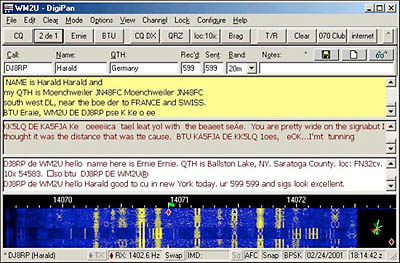


The "PSK" stands for Phase Shift Keying, the modulation method that is used to generate the signal "31" is the bit rate. Peter wanted to design a mode that would do all of its tricks within a very narrow bandwidth.įirst, let's dissect the name. The HF digital subbands are narrow and tend to become crowded in a hurry (particularly during contests). Simply put, he wanted to create a mode that was as easy to use as RTTY, yet much more robust in terms of weak-signal performance. In an article that appeared in RadCom, the journal of the Radio Society of Great Britain, Peter explained why he developed PSK31.
#RTTY VS PSK31 SOFTWARE#
Talk about blasphemy! This meant that any ordinary ham could download the software and become active on PSK31 almost immediately.
#RTTY VS PSK31 FOR FREE#
Not content with creating PSK31 for Windows, Peter placed it on the Web for free distribution to the global ham community. (The gods haven't yet bound him to a rock and summoned an eagle to eat his liver, but that remains to be seen!)
#RTTY VS PSK31 PC#
Like Prometheus bringing fire to the mortals, however, Peter blew the doors wide open by creating a Windows version of PSK31 that did all of its DSP magic using ordinary 16-bit PC sound cards. That was all well and good, but it kept PSK31 in the shadowy corners of our hobby where few knew it existed. Up until relatively recently, PSK31 was the favorite of a small cadre of experimenters who used DSP development kits to put the mode on the air. If the call sign seems familiar, you might recall Peter as the father of AMTOR. PSK31 was the brainchild of Peter Martinez, G3PLX. In other words, it is completely free of key clicks! This means that the CW generated by the PSK31 program is actually narrower than average CW. It's interesting to note that the CW identifier, which is a part of the PSK31 software currently available, is limited to the same spectrum width as the PSK31 signal itself. Something, however, has arrived that has the potential to knock RTTY out of the spotlight. No, RTTY hasn't been tossed onto the ash heap of ham history-at least not yet. No doubt you've noticed that I've been speaking of RTTY in the past tense. It wasn't as fast as phone, of course, but you could maintain a decent "rate." During digital contests and DX pileups, RTTY became a mode of rapid-fire contacts. Conversations flowed easily and roundtable discussions (and nets) were possible. Unlike the 'TOR modes, you didn't have to worry about setting up handshaking links type-and-transmit was the order of the day for RTTY. But for contesting, DXpeditions and just casual conversation, RTTY was hard to beat. RTTY didn't have the error-free copy of the handshaking modes, and you certainly could not swap binary files using its limited code. Still, like most HF digital enthusiasts, I kept coming back to RTTY. (Personal computer? What's that?) I jumped on the AMTOR bandwagon in the '80s and dabbled in CLOVER, G-TOR and PACTOR II in the '90s. We have a warm relationship that goes back to my new-ham days in the early '70s when I was pounding green keys and reading conversations off rolls of yellow teletype paper. HF-PACKET and UHF-PACKET (AX25) are supported in KISS-TNC emulation mode.There's a new HF digital mode in town and the gossip is flying! RTTY (Baudot code), ASCII (7 or 8 bits), PSK31 (BPSK and QPSK),BPSK63, AMTOR-FEC (SITOR-B, NAVTEX), MFSK-16, MFSK-8. MT63,MFSK,PACTOR I(TX/RX), SSTV,DIGSSTV,ACARS,THROB,APRS,CCW/CW,PSKFEC31/PSK31/63/PSKAM,PSK220F,RTTY,HELL,CW,FSK, OLIVIA,PAX/PAX2,Chip64/128,Video ID, Domino EX FEC, DIGIVOICE,RTTYM,CONTESTIA,TCP/IP digital modem, ALE400(ALE141A), JT65, IQ, CALL IDĬW-OLIVIA(+64/2000)-DOMINOEX-MT63-THROB(X)-MFSK-RTTY-QPSK/BPSK31/63/125, SSTV PSK, RTTY, HELL, CW, OLIVIA, MFSK, Domino EX ,THOR, ARQ Digital Signal Processing for Amateur Radio


 0 kommentar(er)
0 kommentar(er)
